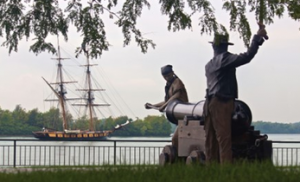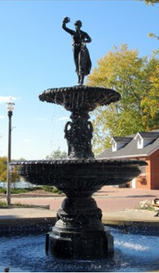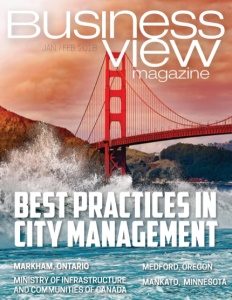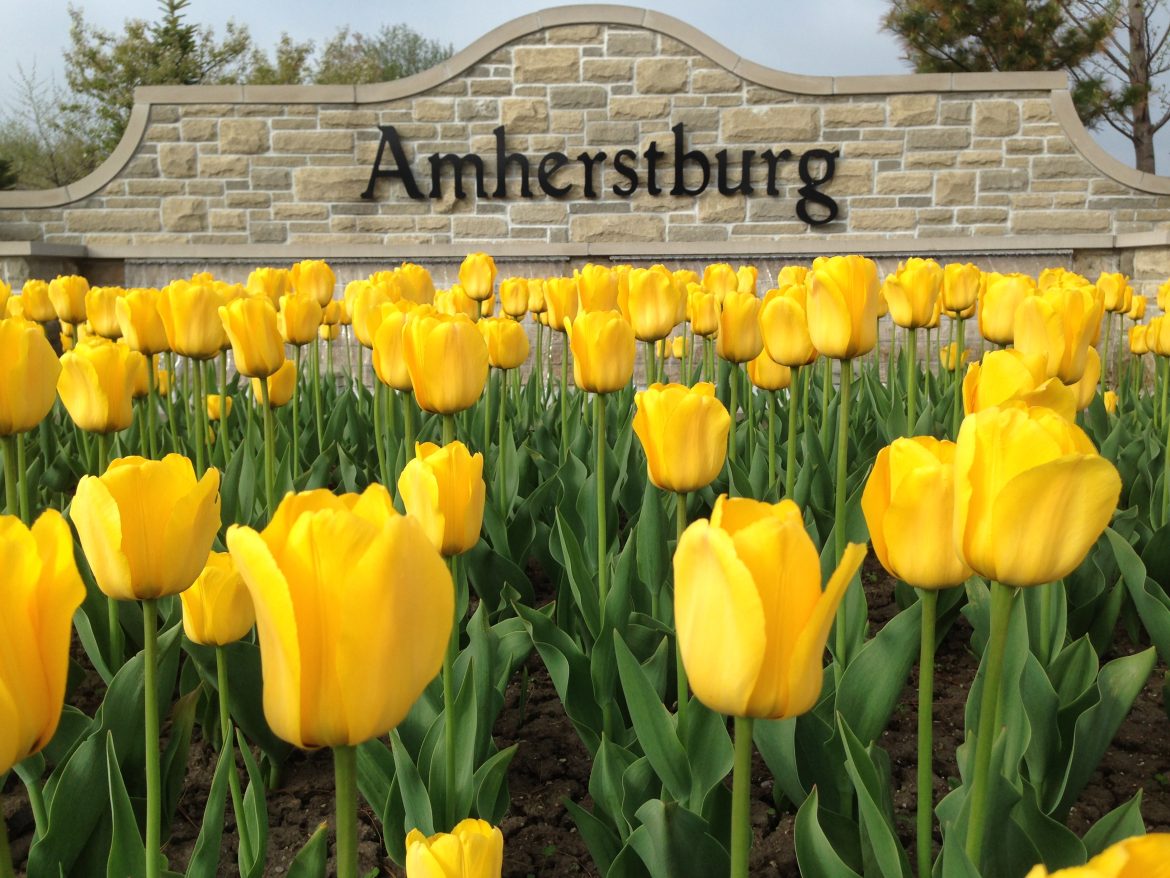Business View Magazine interviews Aldo DiCarlo, Mayor of Amherstburg, Ontario and CAO John Miceli, for our focus on Sustainability in Canadian Cities.
Cue the applause! After years of begging, pleading, wishing from residents and businesses, the Town of Amherstburg, Ontario recently announced fiber high-speed connectivity is coming to the entire town -rural properties included! Thanks to an investment “north of $12 million” from Bell Canada, fiber optic broadband internet is expected to be available to every Amherstburg home within the next two years.
Business View Magazine recently spoke about this exciting news and other developments with Amherstburg Mayor, Aldo DiCarlo, and CAO, John Miceli – two leaders known for galvanizing initiatives in this ambitious southern Ontario municipality. The following is an edited transcript of that conversation.
BVM: Congratulations on high-speed coming to Amherstburg! Would you like to share the story?
Miceli: “We certainly would. One of the pillars identified in our Strategic Plan as something that residents wanted delivered by Council was high-speed internet throughout the community. We are now excited to announce a private sector partner, Bell Canada, has agreed to connect every home in the municipality to high-speed fiber optic broadband within a 24-month window, starting in 2018. Work will start in the core and branch out from there. At present, we have a lot of young families who want to move here, but us not having high-speed internet has been a challenge. It will also facilitate the growth of small business. Providing high-speed in a home-based business  environment will be a great opportunity from a costing perspective. We already have the lowest priced housing with the most amenities to offer in the region for a municipality our size.”
environment will be a great opportunity from a costing perspective. We already have the lowest priced housing with the most amenities to offer in the region for a municipality our size.”
DiCarlo: “This isn’t just about watching videos and streaming. It’s about communication. This project is a key economic driver for us. Amherstburg will be one of only a few small towns with border-to-border fiber internet service, from the town core to concession roads. We’re happy, we’re excited, we’re proud to say that we were able to work with Bell and get, not just fiber to the home, but fiber to the farm. The bonus is that it will cost the town nothing, other than a willingness to help expedite the process by giving the company streamlined access to permits and city records.”
BVM: More good news; we also hear that last year was a banner year for tourism in Amherstburg?
Miceli: “Huge. Our tourism has gone up 42 percent from last year. In 2016/2017, we hosted the Canada 150 event, where we had 80,000 visitors on one weekend. We are the premier destination in the southwest region, as it relates to Essex County, and we’re building our operating budget to support further expansion of tourism. We also purchased a piece of waterfront property to expand one of our biggest attractions – the 10.5-acre King’s Navy Yard Park. The proposed development entails an amphitheater, a festival plaza, and a transient marina with 56 slips on the Detroit River. We demolished the hotel and restaurant that were on the site, and we’re going through the environmental assessment and public consultation for that development now.”
DiCarlo: “The town of Amherstburg used to be a major waterfront destination, especially for Americans right across the Detroit River. Our goal is to bring that back. I’ve been contacted by yacht and boating groups that have seen in the media what we’re proposing, and they’ve been very supportive. They see Amherstburg as a perfect destination for boaters. At the base of the proposed marina is our version of a ‘downtown’ shopping corridor. That’s what they find so appealing. They could dock their boat, and have the restaurants, stores, heritage properties, parks, all in walking distance along that main street and spilling over into the rest of town.”
BVM: Will there be residential development in that area?
Miceli: “We’re going through a community improvement plan; establishing urban design standards to facilitate the preservation of our downtown core in the heritage fashion, with incentives provided for façade improvements. And, we’d like to get a hotel, which will work in with our plan for the waterfront, transient marina, and the downtown. We’re also embarking on a seniors’ master plan. Currently, 20 percent of our population is seniors. That’s expected to jump to 25 percent in the next four years. We want to make sure we’re a welcoming community, that’s not only walkable in our downtown core, but also offering programming and amenities for seniors.
“We have one new subdivision “Meadowview” that’s come  on-stream. Our market tells us most of the seniors are looking for semi-detached or townhouses and that new development will accommodate that. We also have an extension of Kingsbridge subdivision coming in 2018. The initial phase of 58 lots has been sold out, and we’re working on a development plan to bring in municipal infrastructure for our southeast quadrant, which will allow another 1500 lots to be put on-stream.”
on-stream. Our market tells us most of the seniors are looking for semi-detached or townhouses and that new development will accommodate that. We also have an extension of Kingsbridge subdivision coming in 2018. The initial phase of 58 lots has been sold out, and we’re working on a development plan to bring in municipal infrastructure for our southeast quadrant, which will allow another 1500 lots to be put on-stream.”
BVM: How are you investing in the future of the business community?
Miceli: “As part of our strategic plan, we have a pillar for marketing the town as a destination for young families and seniors. We’re making investments to support that through our tourism department. We’re making investments through economic development and targeting growth for our business community. Working out this deal for fiber connectivity is a really positive sign for Amherstburg. We are also getting a new state-of-the-art, dual-stream high school.
“The other pillar is investment in infrastructure. One of the key actions was to initiate the necessary service plans to facilitate growth and development. That whole southeast quadrant would not happen if the town didn’t take the lead in oversizing for services to allow the 1500 lots. We’re making a great deal of progress, all within the fourth pillar, which is financial sustainability. We’re doing everything within the means we currently have. Where we don’t have the means, we’re going to partner with people to make sure we can deliver it.”
BVM: Anything else you’d like to add about the importance of high-speed communication for Amherstburg?
Miceli: “A community can’t survive these days without high-speed internet. I view it the same as water or sewers. If you don’t have those you can’t have a thriving municipality. Where we’re located, just 20 minutes from Windsor, we have so many amenities to offer. By putting this other tool in our toolbox, it’s going to play a very strategic role in the rapid growth of our community. In addition, we’ve become the most progressive municipality in our region with a new public engagement platform www.talktheburg.ca. It highlights all our budgetary items, master plans, the waterfront project, and gauges feedback from residents, all on one site.”
DiCarlo: “People will communicate with you on all social formats. We have all those channels, plus the new website. Now, we’ll be the very first municipality in our region to boast 100 percent coverage of high-speed internet. My catch phrase is ‘We’re not just doing fiber to the home; we’re doing fiber to the farm.’ That’s what’s going to set us apart. You can find fiber to the home all over the place, but it’s always in these concentrated, congested areas of municipalities that are obviously using money for businesses. The problem for the average Ontario municipality is with the large rural areas – and we all have them. That’s where our focus is, to get those people the communication they need. Farmers, today, are doing business all over the world, and with that comes the need for communication. What we vowed was, moving forward, we would not forget about them.
“In my day job as an electronics engineer at the University of Windsor, I’ve had the luxury of high-speed internet since the 1990s. One of the things that drove me when I became Mayor was to get it into town. Technology-wise, Amherstburg is a perfect example of a mixed urban/rural Ontario municipality. The urban part of town is not done too bad, but the suburban and rural parts have essentially nothing – some DSL and microwave that is extremely unreliable. Our CAO took it to a whole new level. We went public and said we couldn’t get anybody to do it. Then John went ahead and developed a model for the town to do it, itself, if no one else would. Not only are we getting it done now, but we’ve partnered with Bell Canada to make it reality in 18 to 24 months. Amazing!
“In the past we managed to get a lot of isolated ideas done, the big difference now is we’re getting a lot more done, and everything makes sense as we pull it all together.”
AT A GLANCE
WHO: Amherstburg, Ontario
WHAT: Scenic town of 22,000
WHERE: SNear the mouth of the Detroit River in Essex County, Ontario
WEBSITE: www.amherstburg.ca
PREFERRED VENDORS
DIG DIGITAL?




